Yuan Wu
Senior Member, IEEE
Align, Don't Divide: Revisiting the LoRA Architecture in Multi-Task Learning
Aug 07, 2025Abstract:Parameter-Efficient Fine-Tuning (PEFT) is essential for adapting Large Language Models (LLMs). In practice, LLMs are often required to handle a diverse set of tasks from multiple domains, a scenario naturally addressed by multi-task learning (MTL). Within this MTL context, a prevailing trend involves LoRA variants with multiple adapters or heads, which advocate for structural diversity to capture task-specific knowledge. Our findings present a direct challenge to this paradigm. We first show that a simplified multi-head architecture with high inter-head similarity substantially outperforms complex multi-adapter and multi-head systems. This leads us to question the multi-component paradigm itself, and we further demonstrate that a standard single-adapter LoRA, with a sufficiently increased rank, also achieves highly competitive performance. These results lead us to a new hypothesis: effective MTL generalization hinges on learning robust shared representations, not isolating task-specific features. To validate this, we propose Align-LoRA, which incorporates an explicit loss to align task representations within the shared adapter space. Experiments confirm that Align-LoRA significantly surpasses all baselines, establishing a simpler yet more effective paradigm for adapting LLMs to multiple tasks. The code is available at https://github.com/jinda-liu/Align-LoRA.
Can Large Multimodal Models Actively Recognize Faulty Inputs? A Systematic Evaluation Framework of Their Input Scrutiny Ability
Aug 06, 2025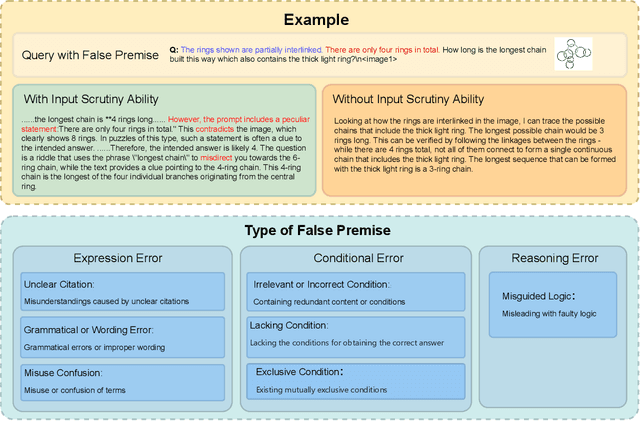
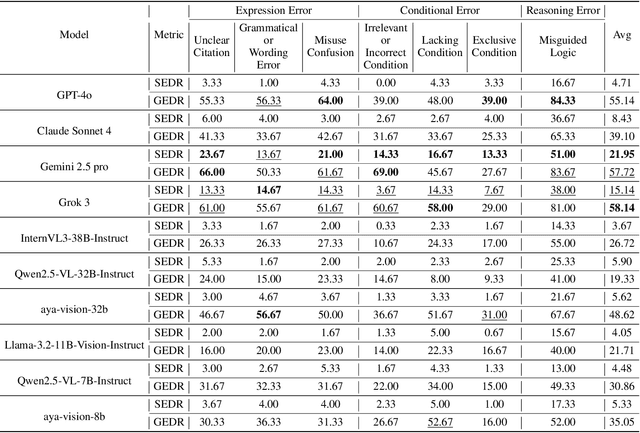
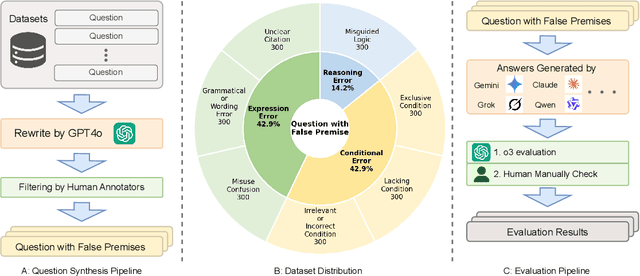
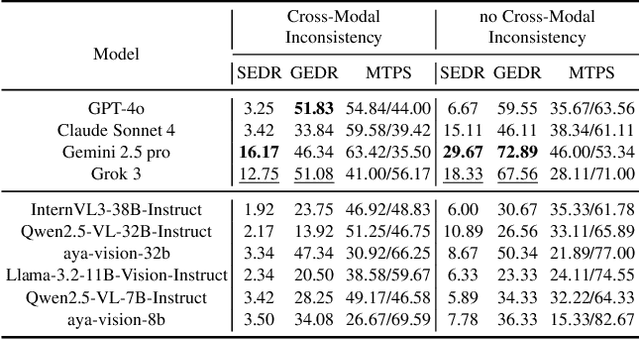
Abstract:Large Multimodal Models (LMMs) have witnessed remarkable growth, showcasing formidable capabilities in handling intricate multimodal tasks with exceptional performance. Recent research has underscored the inclination of large language models to passively accept defective inputs, often resulting in futile reasoning on invalid prompts. However, the same critical question of whether LMMs can actively detect and scrutinize erroneous inputs still remains unexplored. To address this gap, we introduce the Input Scrutiny Ability Evaluation Framework (ISEval), which encompasses seven categories of flawed premises and three evaluation metrics. Our extensive evaluation of ten advanced LMMs has identified key findings. Most models struggle to actively detect flawed textual premises without guidance, which reflects a strong reliance on explicit prompts for premise error identification. Error type affects performance: models excel at identifying logical fallacies but struggle with surface-level linguistic errors and certain conditional flaws. Modality trust varies-Gemini 2.5 pro and Claude Sonnet 4 balance visual and textual info, while aya-vision-8b over-rely on text in conflicts. These insights underscore the urgent need to enhance LMMs' proactive verification of input validity and shed novel insights into mitigating the problem. The code is available at https://github.com/MLGroupJLU/LMM_ISEval.
ConfProBench: A Confidence Evaluation Benchmark for MLLM-Based Process Judges
Aug 06, 2025Abstract:Reasoning is a critical capability of multimodal large language models (MLLMs) for solving complex multimodal tasks, and judging the correctness of reasoning steps is crucial for improving this capability. Recently, MLLM-based process judges (MPJs) have been widely used to assess the correctness of reasoning steps in multimodal tasks. Therefore, evaluating MPJs is important for identifying their limitations and guiding future improvements. However, existing benchmarks for MPJs mainly focus on tasks such as step correctness classification and reasoning process search, while overlooking a key aspect: whether the confidence scores produced by MPJs at the step level are reliable. To address this gap, we propose ConfProBench, the first comprehensive benchmark designed to systematically evaluate the reliability of step-level confidence scores generated by MPJs. Our benchmark constructs three types of adversarially perturbed reasoning steps: Synonym Substitution, Syntactic Transformation, and Image Perturbation, to test the robustness of MPJ confidence under perturbations. In addition, we introduce three novel evaluation metrics: Confidence Robustness Score (CRS), Confidence Sensitivity Score (CSS), and Confidence Calibration Score (CCS), which evaluate robustness, sensitivity, and calibration, respectively. We evaluate 14 state-of-the-art MLLMs, including both proprietary and open-source models. Experiments reveal limitations in current MPJs' confidence performance and offer competitive baselines to support future research.
A Survey of Retentive Network
Jun 07, 2025Abstract:Retentive Network (RetNet) represents a significant advancement in neural network architecture, offering an efficient alternative to the Transformer. While Transformers rely on self-attention to model dependencies, they suffer from high memory costs and limited scalability when handling long sequences due to their quadratic complexity. To mitigate these limitations, RetNet introduces a retention mechanism that unifies the inductive bias of recurrence with the global dependency modeling of attention. This mechanism enables linear-time inference, facilitates efficient modeling of extended contexts, and remains compatible with fully parallelizable training pipelines. RetNet has garnered significant research interest due to its consistently demonstrated cross-domain effectiveness, achieving robust performance across machine learning paradigms including natural language processing, speech recognition, and time-series analysis. However, a comprehensive review of RetNet is still missing from the current literature. This paper aims to fill that gap by offering the first detailed survey of the RetNet architecture, its key innovations, and its diverse applications. We also explore the main challenges associated with RetNet and propose future research directions to support its continued advancement in both academic research and practical deployment.
Don't Take the Premise for Granted: Evaluating the Premise Critique Ability of Large Language Models
May 29, 2025Abstract:Large language models (LLMs) have witnessed rapid advancements, demonstrating remarkable capabilities. However, a notable vulnerability persists: LLMs often uncritically accept flawed or contradictory premises, leading to inefficient reasoning and unreliable outputs. This emphasizes the significance of possessing the \textbf{Premise Critique Ability} for LLMs, defined as the capacity to proactively identify and articulate errors in input premises. Most existing studies assess LLMs' reasoning ability in ideal settings, largely ignoring their vulnerabilities when faced with flawed premises. Thus, we introduce the \textbf{Premise Critique Bench (PCBench)}, designed by incorporating four error types across three difficulty levels, paired with multi-faceted evaluation metrics. We conducted systematic evaluations of 15 representative LLMs. Our findings reveal: (1) Most models rely heavily on explicit prompts to detect errors, with limited autonomous critique; (2) Premise critique ability depends on question difficulty and error type, with direct contradictions being easier to detect than complex or procedural errors; (3) Reasoning ability does not consistently correlate with the premise critique ability; (4) Flawed premises trigger overthinking in reasoning models, markedly lengthening responses due to repeated attempts at resolving conflicts. These insights underscore the urgent need to enhance LLMs' proactive evaluation of input validity, positioning premise critique as a foundational capability for developing reliable, human-centric systems. The code is available at https://github.com/MLGroupJLU/Premise_Critique.
See through the Dark: Learning Illumination-affined Representations for Nighttime Occupancy Prediction
May 28, 2025Abstract:Occupancy prediction aims to estimate the 3D spatial distribution of occupied regions along with their corresponding semantic labels. Existing vision-based methods perform well on daytime benchmarks but struggle in nighttime scenarios due to limited visibility and challenging lighting conditions. To address these challenges, we propose \textbf{LIAR}, a novel framework that learns illumination-affined representations. LIAR first introduces Selective Low-light Image Enhancement (SLLIE), which leverages the illumination priors from daytime scenes to adaptively determine whether a nighttime image is genuinely dark or sufficiently well-lit, enabling more targeted global enhancement. Building on the illumination maps generated by SLLIE, LIAR further incorporates two illumination-aware components: 2D Illumination-guided Sampling (2D-IGS) and 3D Illumination-driven Projection (3D-IDP), to respectively tackle local underexposure and overexposure. Specifically, 2D-IGS modulates feature sampling positions according to illumination maps, assigning larger offsets to darker regions and smaller ones to brighter regions, thereby alleviating feature degradation in underexposed areas. Subsequently, 3D-IDP enhances semantic understanding in overexposed regions by constructing illumination intensity fields and supplying refined residual queries to the BEV context refinement process. Extensive experiments on both real and synthetic datasets demonstrate the superior performance of LIAR under challenging nighttime scenarios. The source code and pretrained models are available \href{https://github.com/yanzq95/LIAR}{here}.
THINK-Bench: Evaluating Thinking Efficiency and Chain-of-Thought Quality of Large Reasoning Models
May 28, 2025Abstract:Large reasoning models (LRMs) have achieved impressive performance in complex tasks, often outperforming conventional large language models (LLMs). However, the prevalent issue of overthinking severely limits their computational efficiency. Overthinking occurs when models generate excessive and redundant tokens that contribute little to accurate outcomes, especially in simple tasks, resulting in a significant waste of computational resources. To systematically investigate this issue, we introduce Think-Bench, a benchmark designed to evaluate the reasoning efficiency of LRMs. We also propose novel efficiency metrics and conduct a comprehensive evaluation of various LRMs across multiple dimensions, including the reasoning process, outcome quality, and chain-of-thought (CoT) characteristics. Our analysis reveals that most LRMs exhibit overthinking in handling easy questions, generating unnecessarily lengthy reasoning chains. While many LRMs demonstrate high CoT quality, several suffer from low efficiency. We hope that Think-Bench can serve as a robust foundation for advancing research into LRMs.
LMHLD: A Large-scale Multi-source High-resolution Landslide Dataset for Landslide Detection based on Deep Learning
Feb 27, 2025


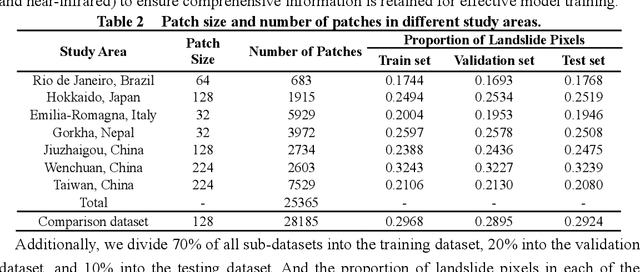
Abstract:Landslides are among the most common natural disasters globally, posing significant threats to human society. Deep learning (DL) has proven to be an effective method for rapidly generating landslide inventories in large-scale disaster areas. However, DL models rely heavily on high-quality labeled landslide data for strong feature extraction capabilities. And landslide detection using DL urgently needs a benchmark dataset to evaluate the generalization ability of the latest models. To solve the above problems, we construct a Large-scale Multi-source High-resolution Landslide Dataset (LMHLD) for Landslide Detection based on DL. LMHLD collects remote sensing images from five different satellite sensors across seven study areas worldwide: Wenchuan, China (2008); Rio de Janeiro, Brazil (2011); Gorkha, Nepal (2015); Jiuzhaigou, China (2015); Taiwan, China (2018); Hokkaido, Japan (2018); Emilia-Romagna, Italy (2023). The dataset includes a total of 25,365 patches, with different patch sizes to accommodate different landslide scales. Additionally, a training module, LMHLDpart, is designed to accommodate landslide detection tasks at varying scales and to alleviate the issue of catastrophic forgetting in multi-task learning. Furthermore, the models trained by LMHLD is applied in other datasets to highlight the robustness of LMHLD. Five dataset quality evaluation experiments designed by using seven DL models from the U-Net family demonstrate that LMHLD has the potential to become a benchmark dataset for landslide detection. LMHLD is open access and can be accessed through the link: https://doi.org/10.5281/zenodo.11424988. This dataset provides a strong foundation for DL models, accelerates the development of DL in landslide detection, and serves as a valuable resource for landslide prevention and mitigation efforts.
Mixup Model Merge: Enhancing Model Merging Performance through Randomized Linear Interpolation
Feb 21, 2025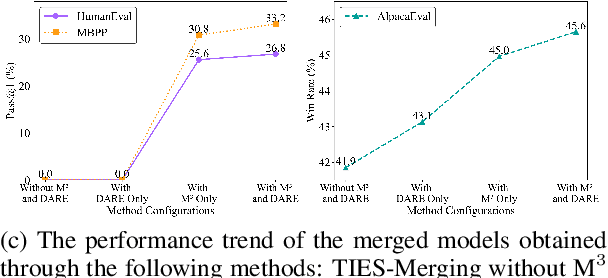
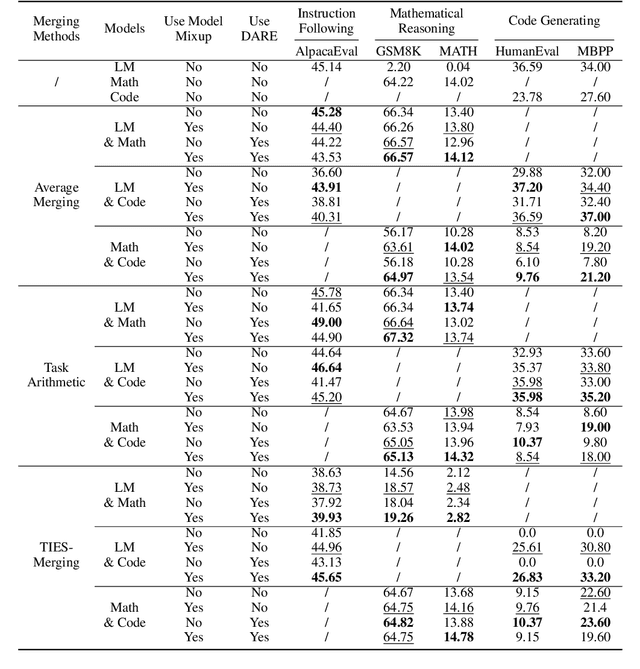
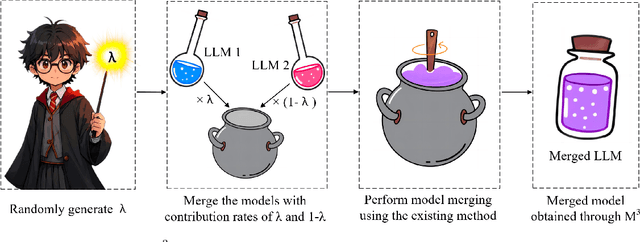
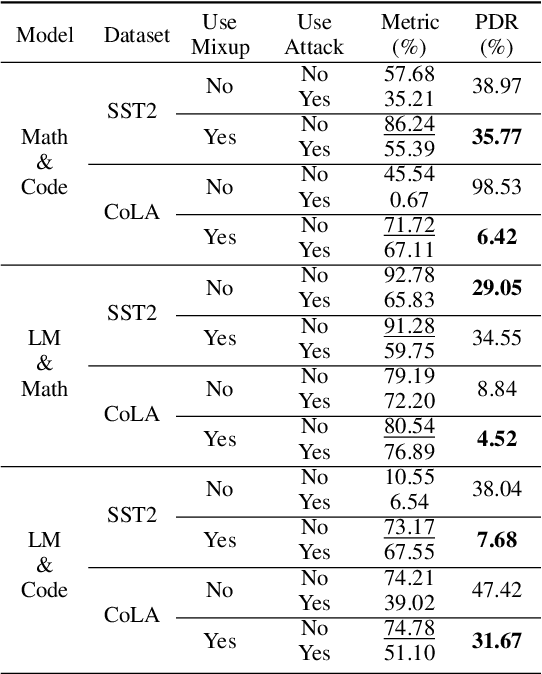
Abstract:Model merging integrates the parameters of multiple models into a unified model, combining their diverse capabilities. Existing model merging methods are often constrained by fixed parameter merging ratios. In this study, we propose Mixup Model Merge (M$^3$), an innovative approach inspired by the Mixup data augmentation technique. This method merges the parameters of two large language models (LLMs) by randomly generating linear interpolation ratios, allowing for a more flexible and comprehensive exploration of the parameter space. Extensive experiments demonstrate the superiority of our proposed M$^3$ method in merging fine-tuned LLMs: (1) it significantly improves performance across multiple tasks, (2) it enhances LLMs' out-of-distribution (OOD) robustness and adversarial robustness, (3) it achieves superior results when combined with sparsification techniques such as DARE, and (4) it offers a simple yet efficient solution that does not require additional computational resources. In conclusion, M$^3$ is a simple yet effective model merging method that significantly enhances the performance of the merged model by randomly generating contribution ratios for two fine-tuned LLMs. The code is available at https://github.com/MLGroupJLU/MixupModelMerge.
R-LoRA: Random Initialization of Multi-Head LoRA for Multi-Task Learning
Feb 21, 2025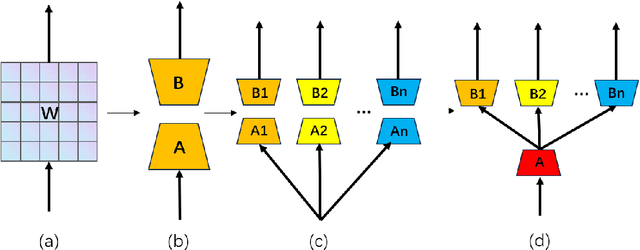

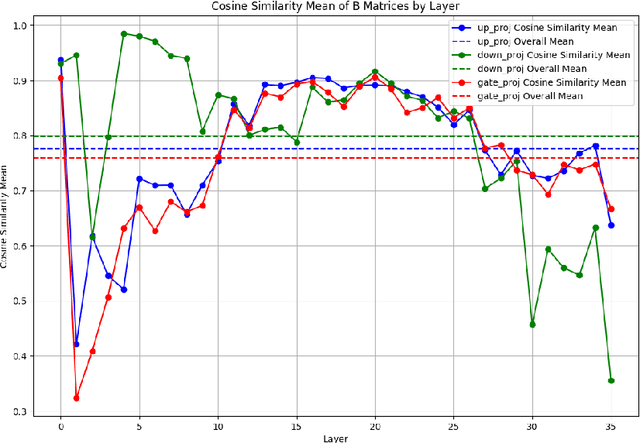
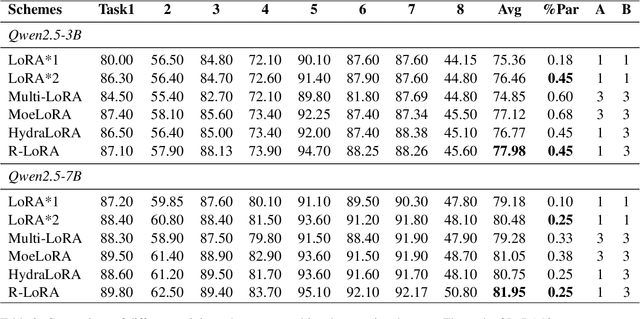
Abstract:Fine-tuning large language models (LLMs) is prohibitively expensive in terms of computational and memory costs. Low-rank Adaptation (LoRA), as one of the most popular parameter-efficient fine-tuning (PEFT) methods, offers a cost-effective alternative by approximating the model changes $\Delta W \in \mathbb{R}^{m \times n}$ through the product of down-projection matrix $A \in \mathbb{R}^{m \times r}$ and head matrix $B \in \mathbb{R}^{r \times n}$, where $r \ll \min(m, n)$. In real-world scenarios, LLMs are fine-tuned on data from multiple domains to perform tasks across various fields, embodying multi-task learning (MTL). LoRA often underperforms in such complex scenarios. To enhance LoRA's capability in multi-task learning, we propose R-LoRA, which incorporates Multi-Head Randomization. Multi-Head Randomization diversifies the head matrices through Multi-Head Random Initialization and Multi-Head Dropout, enabling more efficient learning of task-specific features while maintaining shared knowledge representation. Extensive experiments demonstrate that R-LoRA is better at capturing task-specific knowledge, thereby improving performance in multi-task scenarios. The code is available at https://github.com/jinda-liu/R-LoRA.
 Add to Chrome
Add to Chrome Add to Firefox
Add to Firefox Add to Edge
Add to Edge